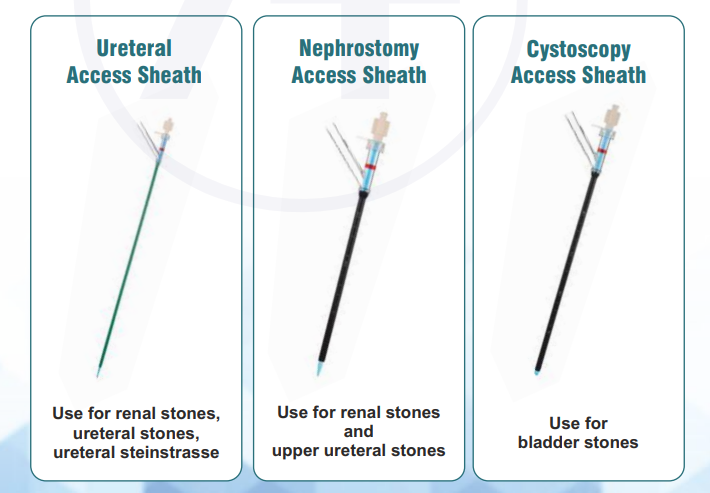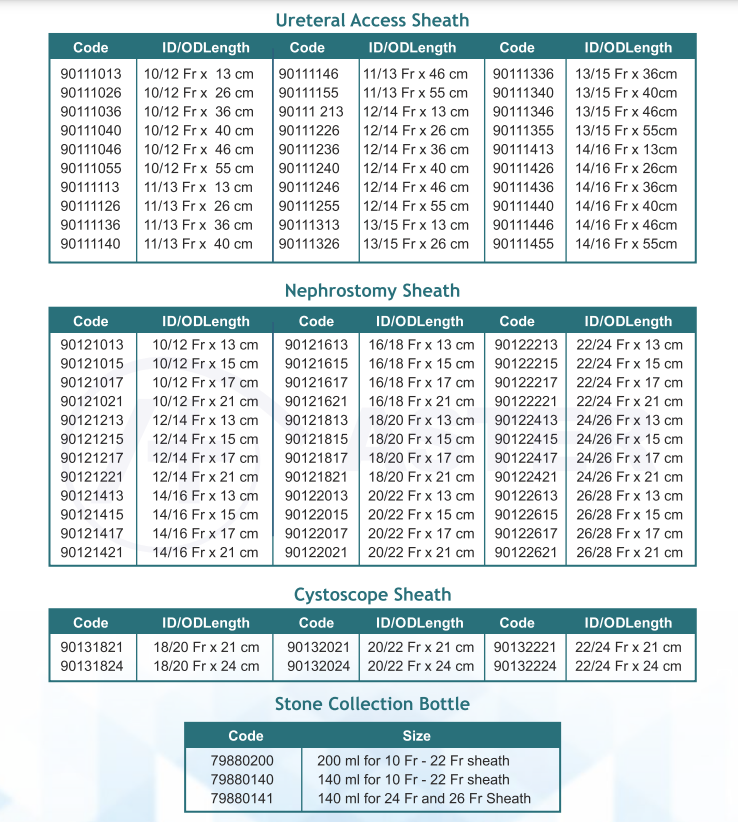
Suction Evacuation Sheath
Benefits
1. Reduces lntra-luminal Pressure : A vortex is created by the continuous irrigation and suction. It reduces the operational (intra-luminal) pressure and reduces the risk of surgery.
2. No More Stone Retropulsion : Effectively prevents retrograde stone migration with Negative Pressure Aspiration and at the same time removes the stone fragments.
3. Improved Visual Field :Under the continuous irrigation and suction, bleeding and dust storm from stone pulverization no longer obscure the visual field.
4. Improved Stone Clearance : Stone fragments will aggregate at the distal end of the Suction Evacuation Sheath instead of scattering and are removed through the oblique side port on the Suction Evacuation Sheath by the continuous suction.
5. No Accessory Device Required : Effectively prevents retrograde stone migration with Negative Pressure Aspiration and at the same time removes the stone fragments.

INSTRUCTION FOR USE
Advance the Suction Evacuation Sheath over a guide wire until it is within 1 cm of the stone or steinstrasse. Remove the obturator and place the rubber cap onto the proximal straight end.
Connect the oblique tube of the Suction Evacuation Sheath to a negative pressure aspirator or to the stone collection bottle with the clear tubing (packed separately) then onto the negative pressure aspirator. Activate the suction at continuous mode and maintain the pressure at 150 - 200 mm Hg.
Insert the endoscope through the center aperture of the rubber cap and turn on the continuous pressurized irrigation at a flow of 50 to 100 cc per minute. Advance the scope to the stone or the steinstrasse. Commence the lithotripsy using a Holmium-YAG Laser or pneumatic lithotripter. We recommend using a higher frequency and lower energy setting on the laser for finer stone fragmentation.
When using the Suction Evacuation Sheath the negative aspiration pressure can be adjusted using the pressure vent on the oblique side port of the sheath, or the pressure control knob located on the egress tube of the stone collection bottle. During the process of lithotripsy, the stone fragments tend to aggregate at the distal opening of the Suction Evacuation Sheath. The small stone fragments will exit in the space between the scope and the Suction Evacuation Sheath. With larger fragments that are small enough to come into the Suction Evacuation Sheath but too large to pass in the space between the scope and the Suction Evacuation Sheath withdraw the scope slowly to just proximal to the bifurcation (the red band) of the Suction Evacuation Sheath. This will open up an unimpeded channel to the oblique tube to allow evacuation of the larger stone fragments.
After the surgery is completed, turn off the perfusion equipment and the negative pressure aspirator. Send the stone collection bottle with stone fragments to the laboratory for urinary stone analysis.
NOTICE
- Use endoscopes at least 3 Fr smaller and 7 cm longer than the Suction Evacuation Sheath.
- Make sure the tip of the Suction Evacuation Sheath is within 5-1 0 mm distance of the stone.
- Set the continuous negative aspiration at 150-200 mm Hg pressure
- Set the continuous pressurized irrigation at 50-100 cc per minute.
- Turn on the suction before the pressurized irrigation.
